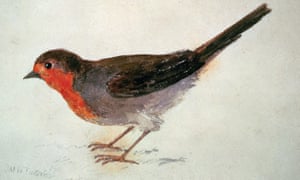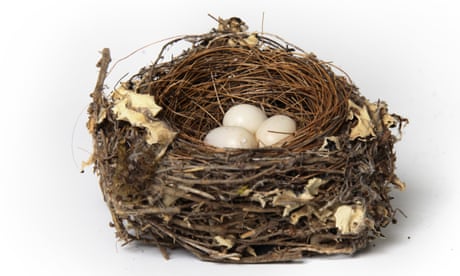
The Robin: A Biography by Stephen Moss – red in tweet and claw.This portrait of a British favourite is engaging but brings little new to the bird table…
Big-eyed and baby-faced with a soft, plump body, but with an expression and demeanour too pert to be cuddly. A breast of such warm blood-orange that it might be an opened heart. A red that pumps on patches of winter grass in countless gardens across Britain, a ruddy medal announcing something heated from within: the bird’s pluck or fight. But a bird so often advancing towards us rather than flying away. And, doing so, becoming our familiar. The household bird with the red stomacher, John Donne called the robin. And its habit of seeking food by turning over leaves in a woodland glade, or investigating the earth dug by a farmer or gardener’s spade, led the bird to be associated with human burials: “A Robbyn readbreast,” Thomas Lupton wrote in 1579, “finding the dead body of a Man or Woman, wyll cover the face of the same with Mosse.” The story of the Babes in the Wood draws on this belief.



JMW Turner’s portrait of ‘Robin Redbreast’, c1815.
Nowadays our source might be in the Christmas post but even in this era of the great thinning of nature we all still know the robin. To a degree, that is. A portrait of the species for non-expert fans is therefore to be welcomed. Stephen Moss’s neat account of the bird’s well-studied life history adds nice observations of his own, told as a year in the robin’s life, from his garden in Somerset where he tallies robins eating berries to a city centre park in London where the birds’ loud song carries over the urban din. He does some modernising of stories, discusses robins’ night-singing under street lights, documents the recent outrageous assassination of three robins at a garden centre, and talks about a much-shared film clip of a robin approaching a grieving mother at the grave of her son. He promises also to tell us more of what the red breast means and what goes on behind it. He ends, however, with little to add to the revelations of one of the first ornithological monographs (and, still, one of the best written), David Lack’s The Life of the Robin, which appeared in the middle of the second world war and which, accidentally or not, enthroned the species as our national bird.
Nowadays our source might be in the Christmas post but even in this era of the great thinning of nature we all still know the robin. To a degree, that is. A portrait of the species for non-expert fans is therefore to be welcomed. Stephen Moss’s neat account of the bird’s well-studied life history adds nice observations of his own, told as a year in the robin’s life, from his garden in Somerset where he tallies robins eating berries to a city centre park in London where the birds’ loud song carries over the urban din. He does some modernising of stories, discusses robins’ night-singing under street lights, documents the recent outrageous assassination of three robins at a garden centre, and talks about a much-shared film clip of a robin approaching a grieving mother at the grave of her son. He promises also to tell us more of what the red breast means and what goes on behind it. He ends, however, with little to add to the revelations of one of the first ornithological monographs (and, still, one of the best written), David Lack’s The Life of the Robin, which appeared in the middle of the second world war and which, accidentally or not, enthroned the species as our national bird.

Helen Macdonald: the forbidden wonder of birds’ nests and eggs
In 2015 the robin re-won the honour (of the nation’s favourite) in a poll beating off the blackbird, the swift and the barn owl. But who wouldn’t want to claim as the best of British a bird that started building a nest in an unmade bed in a house in Birmingham while its human occupant was having his breakfast, or another that built its nest in a hole made by a cannonball on a mast of the Victory, “against which Nelson had been leaning when he was fatally shot”.
Compare the American robin, which is nothing of the sort. European settlers there sensed an impoverishment in the new avifauna they landed among, and were jealous of what they had left behind, so they found a bird (a big and somewhat wormy-looking thrush) that happened to have a red breast and they called it a robin. This imaginative transgenic piracy says much about the intensity of feeling already evolved for the original bird with the red breast.
Moss credits and quotes extensively from David Lack’s book. That study, made over several years in the grounds of Dartington Hall school in Devon, where Lack was a pacifist biology teacher, remains the key robin text. Above all it is a corrective: the imagined friendly bird is actually territorially aggressive and a near-constant fighter. Robert Graves (in The White Goddess) said that in folklore the robin was known to “murder his father”, which accounts for its red breast. This could be true. Lack, famously, used mounted specimens to agitate living robins that attacked the stuffed birds until they were destroyed. He includes photographs of the aftermath. By comparison, Moss’s book has a chintzy design with saccharine images that rather undercut his modernising aspirations.
For the robin, above all, the red breast is a red flag. Later researchers after Lack were able to rouse territorial birds to incandescent fury by simply presenting them with a square of cloth printed in robin redbreast shades. In this and other behaviour robins are different from many of their relations and most other songbirds. Their territoriality extends almost throughout the year. Unusually, female robins hold territories as well as males in the autumn. Unusually, again, the females sing. The silvery balm of robin song in the autumn is one of the great consolations of the silenced season or sounds like that to us. But it is a battlefield for them and the singing, as Lack describes it, like the posturing of bloody breasts and the furious chasing of rivals, is a way of waging war without killing (though that too is sometimes a feature of inter-robin strife). Perhaps the pacifist appreciated this. It still takes its toll on the birds: they live fast and mostly die young. Cats are murderous (Moss says they “may” kill 1.5m robins every year in Britain), but life, in general, is hard. On average robins survive for little more than a year. What we think is our returning robin is almost certainly a new bird filling a gap.
Tim Dee’s Landfill, a book about men and gulls, will appear next year.
In 2015 the robin re-won the honour (of the nation’s favourite) in a poll beating off the blackbird, the swift and the barn owl. But who wouldn’t want to claim as the best of British a bird that started building a nest in an unmade bed in a house in Birmingham while its human occupant was having his breakfast, or another that built its nest in a hole made by a cannonball on a mast of the Victory, “against which Nelson had been leaning when he was fatally shot”.
Compare the American robin, which is nothing of the sort. European settlers there sensed an impoverishment in the new avifauna they landed among, and were jealous of what they had left behind, so they found a bird (a big and somewhat wormy-looking thrush) that happened to have a red breast and they called it a robin. This imaginative transgenic piracy says much about the intensity of feeling already evolved for the original bird with the red breast.
Moss credits and quotes extensively from David Lack’s book. That study, made over several years in the grounds of Dartington Hall school in Devon, where Lack was a pacifist biology teacher, remains the key robin text. Above all it is a corrective: the imagined friendly bird is actually territorially aggressive and a near-constant fighter. Robert Graves (in The White Goddess) said that in folklore the robin was known to “murder his father”, which accounts for its red breast. This could be true. Lack, famously, used mounted specimens to agitate living robins that attacked the stuffed birds until they were destroyed. He includes photographs of the aftermath. By comparison, Moss’s book has a chintzy design with saccharine images that rather undercut his modernising aspirations.
For the robin, above all, the red breast is a red flag. Later researchers after Lack were able to rouse territorial birds to incandescent fury by simply presenting them with a square of cloth printed in robin redbreast shades. In this and other behaviour robins are different from many of their relations and most other songbirds. Their territoriality extends almost throughout the year. Unusually, female robins hold territories as well as males in the autumn. Unusually, again, the females sing. The silvery balm of robin song in the autumn is one of the great consolations of the silenced season or sounds like that to us. But it is a battlefield for them and the singing, as Lack describes it, like the posturing of bloody breasts and the furious chasing of rivals, is a way of waging war without killing (though that too is sometimes a feature of inter-robin strife). Perhaps the pacifist appreciated this. It still takes its toll on the birds: they live fast and mostly die young. Cats are murderous (Moss says they “may” kill 1.5m robins every year in Britain), but life, in general, is hard. On average robins survive for little more than a year. What we think is our returning robin is almost certainly a new bird filling a gap.
Tim Dee’s Landfill, a book about men and gulls, will appear next year.
No comments:
Post a Comment